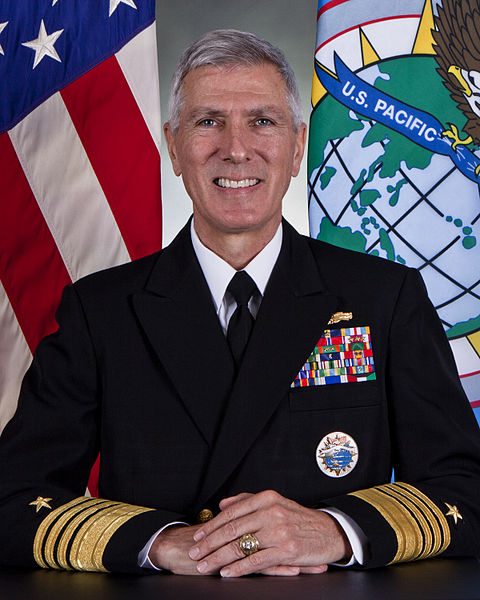 |
| Adm Locklear (Wiki Info) |
By Donna Miles
American Forces Press Service
CAMP SMITH, Hawaii, Aug. 29, 2012 – Calling alliances and partnerships the bedrock of U.S. Asia-Pacific strategy, the commander of U.S. Pacific Command said he’s committed to building on them as he implements the new defense strategy focused on the region.
Navy Adm. Samuel J. Locklear III told American Forces Press Service his theater engagement plan centers on strengthening the U.S. alliances with Australia, Japan, the Philippines, South Korea and Thailand. “These alliances are historic, and they underpin our strategy in the region,” he said.
“We are going to put more time and effort into making sure that those relationships are built for the future,” the admiral said. “The challenge is, how do we ensure that they are durable and satisfactory for the security challenges of the region?”
While addressing that issue, Pacom is widening its aperture to reach out to the other 30 nations in the region, particularly those that share the United States’ interest in security, economic prosperity and human rights.
In a globalized world, no one nation can stand alone – economically, diplomatically or militarily, Locklear said.
“It requires a security environment that has to be collective,” he said, citing the array of transnational threats and challenges. “It can’t be just one country providing the security environment for everyone else’s benefit.”
That’s the value of alliances and partnerships, a central theme in the defense strategic guidance announced in January. “We are going to put more time and effort into making sure that those relationships are built for the future,” the admiral said.
Locklear said he welcomes the “rebalance” in the region, particularly new rotational forces in Australia and Singapore that will increase engagement opportunities with allies and partners.
“What they provide is an ability to work with our allies and to leverage the capabilities of the allies across all aspects of peace to conflict,” he said. The additional presence rotational forces provide creates more regional footholds that could pay off if the United States had to flow more forces to protect U.S. for allied interests there, he said.
Meanwhile, Pacom is going beyond traditional bilateral relationships to encourage closer multilateral relationships among regional nations and organizations. Working together toward common goals, they are “pulling on the same plow, addressing the same problems together and coming up with better solutions for the region,” Locklear said.
“In the end, what we are looking for is regional stability and security,” he continued. “So for our national interests, it is better when everyone pulls together, instead of pulling one against each other or pulling all, just one for one.”
In support of this effort, Air Force Maj. Gen. Michael A. Keltz, who leads Pacom’s strategic planning policy directorate, weaves intensified alliance- and partnership-building initiatives throughout the command’s planning processes.
The nature of the engagements varies widely. But from smaller-scale training focused on building capability within partner militaries to major exercises to promote regional interoperability to health engagements that support regional stability, all help lay the foundations for strong bilateral, trilateral and multilateral partnerships, Keltz said.
In many cases, these efforts focus on common challenges that cross national borders: concern about illicit trafficking and extremism, about protecting international trade routes and lines of communication and about improving resilience against natural disasters.
“We want to be better situated across the entire Pacific to react to these challenges and build those partnership capacities,” Keltz said. “Everyone gains because we are infinitely stronger, working together.”
To maximize the impact of its activities, Pacom is striving to ensure they build on each other and the efforts of other federal agencies and nongovernmental agencies.
“This gives us purpose and direction and a better understanding of the construct where we are going,” Keltz said. “It ensures that everything we do is tied in a synchronized, coordinated way to support U.S. national objectives in the region”
Air Force Brig. Gen. Kenneth S. Wilsbach, Pacom’s deputy director for operations, puts Locklear’s theater engagement strategy, and supporting plans developed by the strategic planning policy directorate, into action across a vast area of operation that spans half the globe.
“We do a lot of coordinating, across the spectrum, to make sure that we have the forces in the right place at the right time to support whatever is going on and whatever might come up,” he said. “We want to make sure that our forces are postured in the theater so that they are available and ready to go in the event that there is a contingency that they have to respond to.”
U.S. engagements occurring across the theater boil down to one basic goal, Wilsbach said: building understanding and trust across the region, and allied and partner military’s ability to work with the U.S. military and with each other. It’s a process he said doesn’t happen overnight and requires regular engagement and communication.
“If you play golf, you know that if you only play once a year, you are going to be pretty terrible at golf,” he said. “But if you play golf once a week or three times a week, you get pretty good at it. So the bottom line is repetition helps.”
The same is true with relationships, he added. “If you only talk to your spouse once every six months, the relationship is probably pretty thin,” he said. “But if you talk to your spouse every day, you’re likely to have a better relationship.”
These principles – repetition and frequency – underscore Pacom’s theater engagement strategy, Wilsbach said. “It focuses on improving performance while promoting relationship-building,” he said. “And those are the side benefits of readiness.”

 Logging you in...
Logging you in...